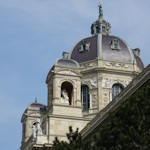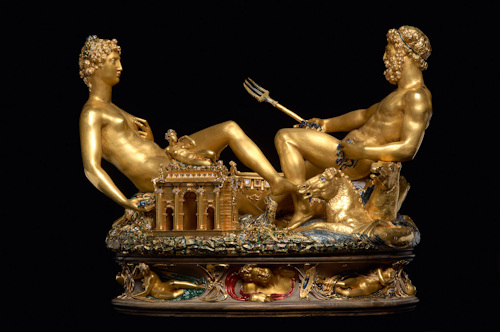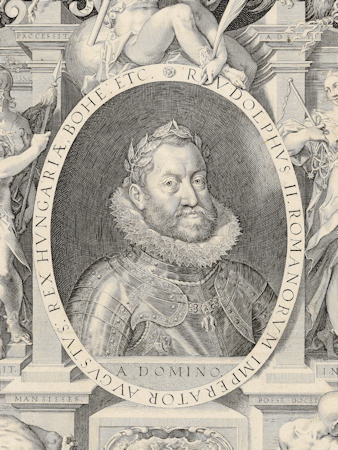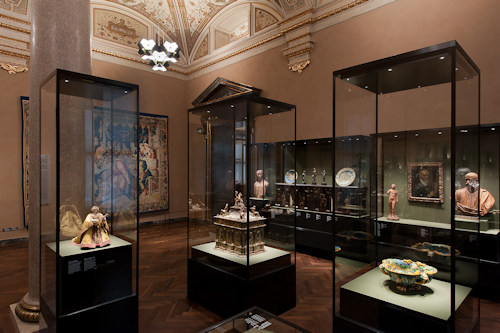
Think of a Kunstkammer as an outlet for the urge to collect, a way to impress your friends and rivals (and subjects), and a showcase for human ingenuity. The Kunsthistorisches Museum’s version is truly breathtaking.
- Astonishing collection of art and artifacts through the ages
- Some pieces leave you in utter awe of the artist’s skill
- Home to the world-famous Saliera
- Book museum tickets* to avoid counter queues
- See also:
Inside the Kunstkammer

(Salt cellar (Saliera) Benvenuto Cellini 1540-1543, Paris, gold, enamel, ebony, ivory 26.3 cm x 28.5 cm x 21.5 cm © Kunsthistorisches Museum Wien)
Historically, individuals and families with considerable wealth would put together a Kunstkammer (chamber of wonders or cabinet of curiosities) to demonstrate the best of nature and humanity’s creative abilities.
Of course, other motivations played a role alongside a desire to serve the greater good.
For example…the more prestigious the items in your Kunstkammer, the better image you project for yourself. Which explains the particular interest in building such a collection among royals and others jostling for exalted position among their peers.
Only a few could afford to build significant collections. After all, renaissance bronze statuary wasn’t high up on your average peasant’s shopping list.
The Kunstkammer inside the Kunsthistorisches Museum showcases the standout items gathered by various members of the Habsburg dynasty from the 16th century onwards.
Consider, for example, the utter magnificence of the Saliera (pictured above): essentially “just” a salt and pepper pot: albeit not dishwasher proof.
The collection fills the lower eastern wing of the museum and is, of course, included in a museum entrance ticket.

(Emperor Rudolf II (1552-1612) was a notable Habsburg contributor to today’s Kunstkammer collection. Here he’s pictured in a 1603 work by Aegidius Sadeler and Hans von Aachen; Wien Museum Inv.-Nr. 13149; excerpt reproduced with permission under the terms of the CC0 licence)
Each of the twenty or so galleries has an overview explaining its theme and/or relevance to art and history, while each item has an accompanying (short) description.
The design and layout carries you along on a journey through changing times and techniques.
The museum also has audio guides available in the main entrance hall. And it’s all in both English and German (see here for general visitor tips for the museum).
So what should you look out for?
The early years
Start with the oldest Kunstkammer items (Galleries 36 and 37), then work your way through history by moving down the gallery numbers.
Those starting galleries feature mainly ecclesiastical items (which dominated early art) from the 11th to 14th centuries. My favourite is the griffon-shaped aquamanile (basically a water jug used for the ritualistic washing of hands) from around 1125.
Someone used that aquamanile while William the Conqueror’s son still sat on the English throne, and Columbus was almost 400 years away from reaching America.
Take a look, also, at the ornament embedded with fossil shark’s teeth in Gallery 35: the so-called Adder’s Tongues Credenza from around 1450.
When they weren’t oppressing the peasantry, the aristocrats tried to outdo each other in demonstrations of wealth using every means possible, including through such items as sideboard decorations.
Back then, they thought shark teeth would sweat or change colour when near poisoned food or drink. A useful property when another aristocratic hobby was to find ways to do away with rivals.
Also check the tiny boxwood rosary pendant displaying the Passion of Christ: I’m pretty sure they didn’t have laser technology in the early 1500s, so I have no idea how they got such incredibly fine detail. A truly astonishing work of art that counts as one of my formal highlights for the Kunsthistorisches Museum.
Michelangelo’s maestro
Among the 15th century figures and busts in Gallery 34, you find the Vanitas Group of three figures carved from a single block of limewood.
The work represents the beauty and (unfortunately) transience of youth. The figure of the older woman feels like a bucket of cold water on the soul with the painted fly adding a macabre touch.
Tucked away innocently in this room is also a bronze statue of Bellerophon taming Pegasus from around 1481 by a chap called Bertoldo di Giovanni.
Nothing special you might think, but imagine this: he was a teacher of Michelangelo. Feels like he did a decent job as an educator, given his pupil went on to product such delights as this.
Take a look also at the collection of plaquettes. In the 15th century and later, these small bronze reliefs served a similar purpose to today’s baseball trading cards and collectible plates. So it’s nice to know that nothing really changes.
The shift to secular

(Saal XXXII © Kunsthistorisches Museum Wien)
Gallery 32 reveals how art began to spread beyond its original – mostly religious – context, and artists started to push back the borders of what’s possible.
This is best illustrated in the ca. 1580 sculpture of two figures by Giambologna, which has a fluidity of apparent movement not seen in earlier bronzes.
Giambologna aimed to create statutes that invite you to walk around them; this sculpture illustrates the principle perfectly. His portrait also hangs on a nearby wall, as if he wished to keep a watchful eye on his work.
The room also has an early automaton or mechanical model: a female cittern player from the late 1500s.
Art as propaganda
Gallery 31 features a sensational carved backgammon set from 1537. The pieces depict intricate literary scenes, while the board’s back shows representations of the Habsburg dynasty, its lands, and its spiritual (though not actual) predecessors, such as Roman emperors.
Be sure to observe the incredible detail, like the small flowers and distant backgrounds accompanying the two horsed emperors.
Here we have a backgammon set as a statement of power and prestige. Imagine the Emperor leaning over and asking a guest if they fancied a game:
Guest:
Why, certainly. Do you have a board handy?
Emperor:
I think we might be able to rustle something up.
[Clicks fingers at a nearby lackey and tries not to smirk.]
Charting progress
As you move from room to room, you develop a strong feel for how different art forms progressed at different rates in different regions. Though it felt to me like the rest of Europe was always trying to catch up with Italy.
The mid-16th century winged altarpiece in gallery 30 looks like it might have been created yesterday, such is the bright and colourful condition.
The many panels depict the story of the bible, but the people all wear 16th century clothing: presumably a treasure trove of fashion fun for modern researchers.
This gallery also has a portrait of Ferdinand I, who founded the Kunstkammer.
The most famous exhibit
Move to Gallery 29 to find the famous Saliera (also known as the Cellini salt cellar), crafted by Benvenuto Cellini and mentioned earlier. (And another entry on my list of museum highlights.)
The 1543 Saliera is a salt and pepper dispenser for the table in the same way a Ferrari is a vehicle.
King Charles IX of France gave the Saliera as a present to Archduke Ferdinand II. The King’s grandfather (Frances I) was the original recipient of this allegory for the cosmos in gold, enamel, ebony and ivory.
The Saliera’s fame comes from the glorious and exquisite nature of the piece itself, but also from its unfortunate theft.
During renovations, an opportunistic passerby scaled the scaffolding and disappeared off with the work in 2003. The authorities recovered the Saliera some three years later.
Gallery 28 continues the theme of progress measured through Kunstkammer art, with the appearance, for example, of measuring instruments.
Allow yourself a little wry smile at the 16th and 17th century precious carved coconuts gilded with silver (coconuts were a little rarer in Europe back then).
Don’t miss the wood, bronze and pearl cabinet from 1560/1570, either. Although designed for storing art, it’s also art in itself, and displayed in a museum that might legitimately claim to be a work of art, too. Art in art in art, one might say.
And remember the boxwood pendant from earlier? Gallery 28 also has some remarkably delicate cherrywood reliefs from 1570/1580.
This bring us to Part II of our excursion: the Kunstkammer Galleries 27 to 19.